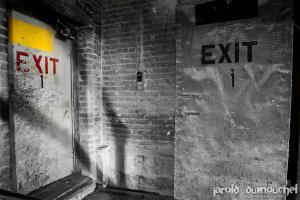Built in 1930, the Wellington tower has ceased operations in 2000. Despite the years that have passed and graffiti artists who came to express their art, the structure of the old tower is still ok. When it was in operation, that's where that were...
The old and abandoned Blachford plant
Chemicals and squatters
From the outside, there is no indication that the plant is abandoned. No window is doomed and there is no "for sale" sign. Even the structure of the building is still in very good condition. I myself had doubts when I heard about it for the first time. The info came from an urbexer who invited me to join him and his friend. Knowing these two photographers by their (very good) reputation, I could not refuse this invitation!
Playing hide and seek with squatters
Closed in 2010, the interior of the plant is still in very good condition, as its façade. We did find a graffiti inside, but it was, at the moment, the only trace of any alteration made there.
But soon enough we discovered that we were not alone. Having already explored the site a few days ago, my two companions ClementRSedona and Gradley Barrett had come across them while they were asleep. We knew that they had taken up residence on the third floor in the lab area. When we arrived, they came to spy on us, hiding behind a big column, but they had probably failed their 101 Spying class because we spotted them immediately. We tried to greet them and tell them that we were only there to take photos, but they ran away back to the third floor.
Thereafter, they tried to block us access to the portion of the building they occupied by blocking a door, but they forgot to do the same with the door next from the first one. As a courtesy, we preferred to leave them alone and thus renounced to great pictures in a portion of the plant that looked very promising.
The story of a family business
In 1921 Henry Lloyd Blachford, 25 years old, founded a sales agency, specialized in chemicals used in the production of rubber, paint and ink. While the war was profitable for the company with several major contracts, the reputation of the latter began to radiate outside the Canada, in the United States and England.
In the 1950s, the company expanded in the Toronto area, allowing it to diversify its offering. Over the following decades, the company built new factories in Troy, Michigan and Mississauga, Ontario, where the production from Montreal began to get transferred to in 1984.
In 1987, the owner and founder of the company, Henry Lloyd Blachford, died only a few weeks after retiring. John, his son, took over the reins of the company.
After an announcement made in November 2009, the Montreal plant was officially closed in 2010, without any fanfare. All production and the 26 jobs were transferred to the Mississauga plant, leaving there an empty shell where only a few relics were left behind. On the Internet, apart from the official statement of the company, no newspaper seemed to have mentioned the closure of the plant.
Related content
Located in the region of Baranja in Croatia, Šećerana is a settlement of 559 inhabitants near Beli Manastir. Today forgotten and half destroyed, the old Baranja Sugar factory has been built in 1898 and became a state company in 1906. Funded with...
I was asked to photograph it (legally) by the Trust group thats restoring the island,which was a life long dream of mine.
The history of the island began in 1900 when Francis Bannerman purchased the island. Located in the Hudson River near...
The history of the Babcock & Wilcox in the Galindo valley began during the First World War when the difficulties of the Compañía de los Caminos de Hierro del Norte de España will result in the sale of the plant to the Babcock & Wilcox...




























































